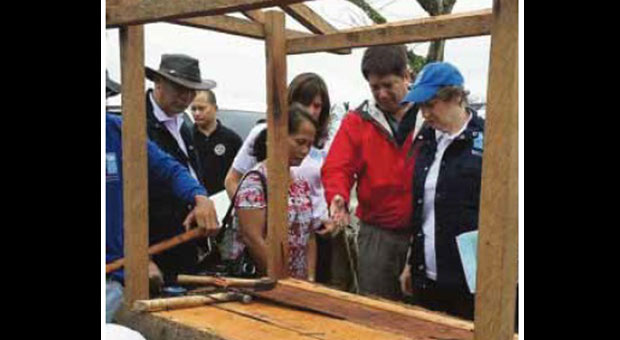Noodle vendor in Tacloban impresses UNDP head

VIP IN LEYTE Former New Zealand Prime Minister Helen Clark, who now heads UNDP, inspects stalls made with lumber salvaged from coconut trees felled by Supertyphoon “Yolanda.” TARRA QUISMUNDO
TACLOBAN CITY, Philippines—For longtime vendor Roger Mabingnay, life in his typhoon-ravaged village has brightened.
“At least now, I have a livelihood again. From zero, now I’m No. 1,” the 42-year-old father of eight told the Inquirer, his eyes as wide as his smile as he tended to his new stall at Fisherman’s Village in Barangay 88, one of the areas hardest hit by Super Typhoon Yolanda.
After some four months of depending on rations, Mabingnay is back in business, his mami (noodle soup) stall standing on a prime spot at the entrance to the village, where displaced families have been staying in temporary shelters.
Among recipients of livelihood assistance from the United Nations Development Program (UNDP), Mabingnay kick-started his store on Monday with a P4,000 capital, plus a new stall made out of lumber salvaged from coconut trees felled by the Nov. 8 typhoon.
“This is the only source of living for my family. This is a big help…. We used to have none, and sometimes, my wife and I would fight,” said Mabingnay, whose house was completely washed out and now stays in a makeshift hut.
A day’s work earns him P300—about a third of what his three “rolling stores” used to make before the storm.
Mabingnay’s disposition so impressed UNDP Administrator Helen Clark that the official took her own snapshot of the vendor with her smartphone.
Clark, former New Zealand prime minister, visited UNDP projects here for about two hours on Wednesday, the second day of a three-day visit to the Philippines.
“For me to see this recovery is very, very encouraging…. I am impressed with what I’ve seen. I know how deep the scars in their hearts are,” said Clark of the typhoon survivors she encountered during her visit.
Livelihood training
“I think, given the incredible severity of what happened, we can only be amazed at how quickly the community has recovered so far,” Clark told reporters in an interview.
While here, the UN official visited a livelihood training site, where workers built coco lumber stalls similar to the Mabingnay’s kiosk.
She also dropped by San Jose Central Elementary School, a public school of some 3,800 pupils, where the UNDP supported debris clearing and provided learning kits as well as water and sanitation facilities.
“In that school, listening to those heart-rending stories of the people there, but knowing that the school was back up again operating in January, that was impressive. So, I think this is a tribute to the resilience of the people by those who have the determination… to get things moving again,” Clark said.
Clark also opened a new hub for UN agencies at a local government office just across from City Hall, an integration of organizations involved in rebuilding work that seeks to “consolidate all our efforts on rehabilitation and construction,” said Tacloban City Mayor Alfred Romualdez.
Biggest concerns
Clark’s visit here sought to highlight the agency’s commitment to stay and keep working with local communities throughout the recovery process, as embodied in the UNDP’s three-year $65-million program. The plan aims to support the operations of the local government, restart livelihood among the worst-affected and continue cash-for-work activities.
Currently, the agency has some $15.5 million in funds, pooled aid from Japan, Ecuador, Russia, the UN Central Emergency Response Fund plus its own. It requires some $49.5 million more.
Lesley Wright, communication and information specialist of UNDP’s Typhoon Yolanda response Team in Tacloban, said the restoration of livelihood and providing shelter remained the biggest concerns in the disaster zone.
She cited the “unified approach” of organizations, local officials and the national government in helping the transition from relief to early recovery, saying “the thrust forward has been quite positive.”
“You can pick apart certain things. You can be critical of certain things of course… I just know on the ground here, the response has been phenomenal and the movement to the next phase has been great,” said Wright.
She was referring to recovery efforts in Haiti after the 2010 earthquake and in Banda Aceh, Indonesia, following the Indian Ocean quake and tsunami of 2004.
“(I)t’s a testament to how the Philippine government and the Philippine community has been able to really bounce back, whether we’re (UNDP) here or not. I really felt that there’s a strong sense of bounce-back and resilience that isn’t in a lot of places I’ve been to,” she said.
RELATED STORIES
Houses for 1,000 families start to rise
Tacloban continues getting help from UN, other groups














